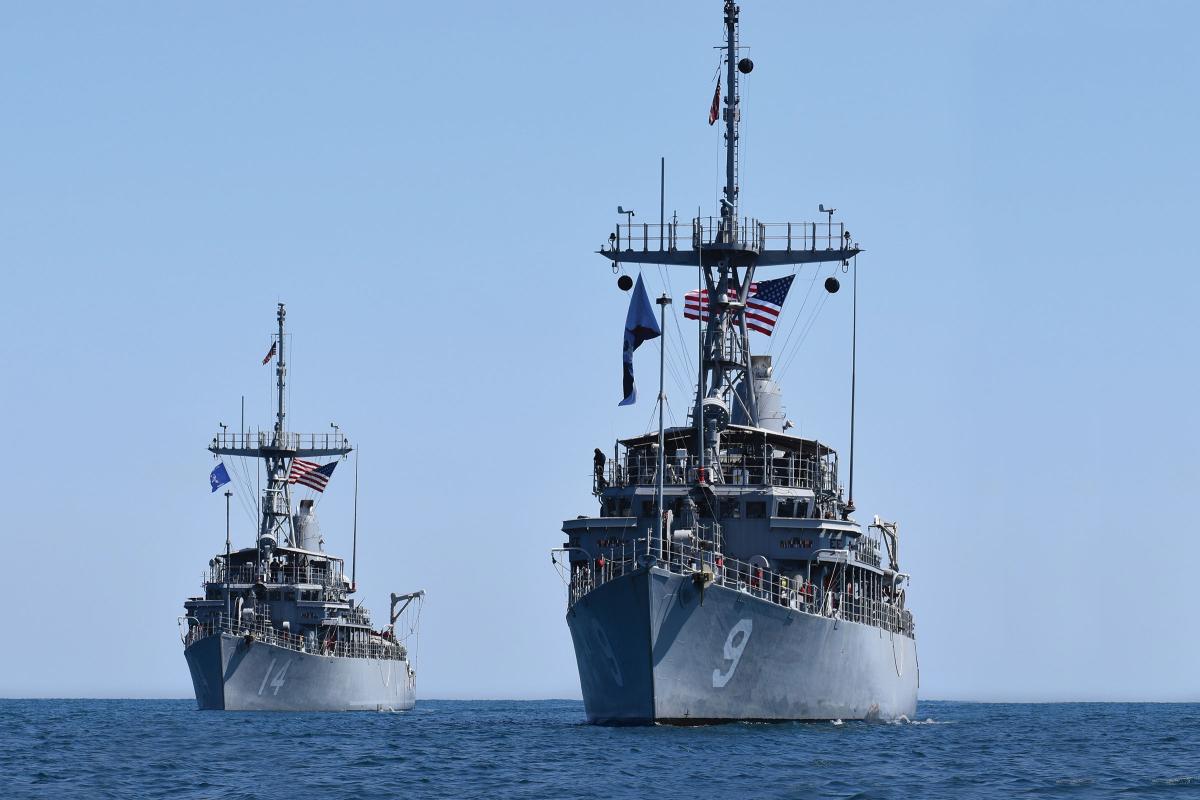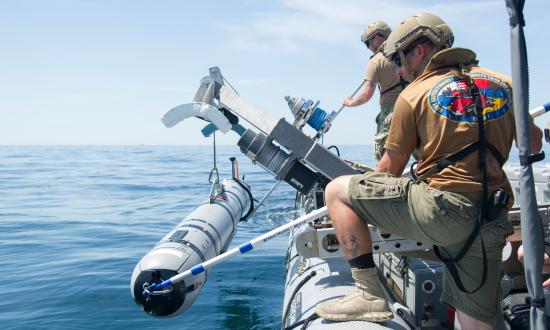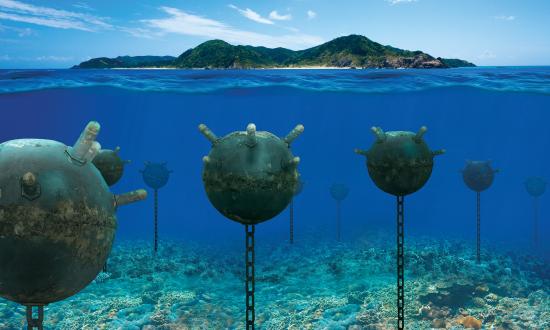The maritime superiority enjoyed by the U.S. Navy since the end of the Cold War is being challenged by the return of great power competition. Although this brings new threats from hypersonic weapons and antiship ballistic missiles, it does not mean older ones, such as mines, can be assumed away.1 Mines could be used to channelize access to a body of water, block sea lines of communication (SLOC), or deny access to or from a port. Such actions—or even the threat of them—could imperil world trade, limit the U.S. Navy’s freedom of action, and generate adverse economic and political effects. To “be the best when the nation needs it the most,” the Navy must be able to reopen SLOCs and ports that have been closed by mines.2 Its mine countermeasures (MCM) force needs to be able to operate confidently in a contested environment, at speed, without giving away follow-on operations and without breaking the bank.
Perhaps the most important of these requirements is the ability to operate in a contested environment. A relevant MCM force must be able to detect and neutralize mines “inside adversary air and missile defense networks,” which requires a force that “can deploy, survive, operate, maneuver, and regenerate in all domains while under attack.”3 To do this, MCM forces must have or be provided with antiair, antisurface, and antisubmarine warfare capabilities and cybersecurity or be able to operate without the likelihood of being detected or readily targetable.
Being able to operate at adequate speed allows the MCM force to complete countermeasure operations within an operationally relevant timeframe. This timeframe could be driven by the political and economic costs of ports closed to maritime traffic or the operational need to take advantage of an adversary’s force disposition or state of readiness. Three components determine the speed of an MCM operation: (1) getting a trained and ready MCM capability to the suspected minefield, (2) finding the mines, and (3) neutralizing the mines or identifying another route.
Shortening the time required for any of these three components, or doing any of them concurrently, reduces the total time required for the MCM operation. Standard deployment factors, such as readiness to deploy, speed of the deployment platform, and any maintenance or recalibration needed to operate once in theater, drive the first factor; the other two are driven by the size of the area to be cleared and the environmental conditions, such as weather and bottom type. Regarding the areas to be cleared, the mines possessed by U.S. adversaries are challenging previously held concepts. Today, mines can be employed at deeper depths or can reposition themselves, meaning MCM forces may need to clear larger areas, and operations may need to be done closer to the commencement of follow-on operations or continuously, to ensure self-propelled mines have not reseeded the field.
Another element of a successful MCM operation is not alerting an adversary to follow-on operations that the MCM force is working to enable. The longer it takes to complete the MCM operation or the greater the measurable signatures of the MCM force, the more opportunity an adversary has to detect the operation and infer the type, scale, likelihood, and location of follow-on operations.
In addition, for an MCM operation to be effective, the MCM force has to be confident that its efforts have reduced the threat or that there was no threat. If it is not confident, the joint force maritime component commander (JFMCC) cannot adequately determine whether the risk of moving additional forces into the cleared area is at an operationally acceptable level. The JFMCC must be satisfied the MCM force has accurately characterized the mine threat and that it is low enough so the risk from using the area is tolerable.
Finally, to ensure an adequate MCM force both now and in the future, the force needs to be affordable. Despite the role mines have played in damaging or sinking ships and shaping maritime operations in previous conflicts, the Navy traditionally has not prioritized funding for MCM capabilities proportionate to those for countering similar threats. It is unrealistic to expect that any MCM force that costs significantly more than the current legacy MCM platforms would get funded.
Five Steps
Much of the Navy’s current and planned MCM force lacks these characteristics. To provide JFMCCs with a force that can turn MCM into a “competitive advantage,” the Navy needs to “think differently.”4 There are five steps the Navy can take now:
1. Add Another Discriminating Function
Independent verification is a key method to increase confidence in a process. Such confidence can be brought to mine countermeasures by measuring more than one characteristic of naval mines. Currently, the most effective and widespread MCM sensors use sonar to generate visual imagery, so human operators, algorithms, and some optical sensors can identify mine-like objects comparing the imagery to a library of known mine shapes. While advances in both sonar and optical MCM systems have improved in the past several years, both are dependent on knowing what mines look like. Relying on this method, MCM operators might not prosecute mines that do not look like known mines, especially if they are obfuscated or camouflaged.
Just as “the prudent mariner will not rely solely on any single aid to navigation,” neither should the MCM operator rely solely on comparing images of objects to known mines.5 To add confidence to the MCM process, an additional discriminating function that measures something besides shape is needed. Several MCM systems have magnetometers to do this; however, metal is not unique to mines—a fair amount rests on the bottom—and numerous mines having reduced magnetic signatures, so the presence of ferrous metal is not a strong discriminator.
What is needed is a way to recognize a mine by what actually makes it hazardous, such as its arming and firing systems and explosive charge. To achieve this, a meaningful portion of MCM research-and-development efforts should be focused on technology that offers the prospect of finding an additional and effective discriminator. Developing a system that identifies whether an object presents an actual hazard and employing it along with existing sensors would provide a JFMCC with a significantly higher confidence level than is currently possible.
2. Establish an MCM Data Management Plan
Every day, Navy MCM sensors are gathering data. This data helps operators and teams hone their skills and make decisions. It also could be used to provide warfare commanders a fuller understanding of the underwater environment and to help bring machine learning to bear for MCM operations.
Research has shown that machine-learning algorithms become more accurate when they are developed from larger and more diverse data sets.6 But to accrue these advantages, the data currently being generated needs to be aggregated and stored in a manner that allows it to be accessed for both operational and research-and-development purposes. To that end, a data management plan that accounts for security and timeliness of transmission needs to be developed and implemented, to increase the speed of and confidence in MCM operations through machine learning.
3. Enable Repetitive, Cross-community Tours
for Unmanned Systems Operators
The enlisted rating structure provides “specialization at appropriate petty officer levels to meet expanding technology.”7 When the Navy incorporated aircraft and submarines, for example, the personnel system responded accordingly, so that the hard-earned tactical experiences gained by an increasingly technical enlisted force could be further developed and leveraged through follow-on tours. This action “empower[ed] Sailors to master skills critical to naval warfare.”8 Today, as it aggressively pursues unmanned systems (UMSs), the Navy should establish a rating that would enable follow-on tours operating UMSs.9
Creating a UMS rating would mean that, in just a few years, a leading chief petty officer assigned to a unit operating unmanned systems would have not only technical and tactical UMS proficiency, but also the type of deckplate, mission-specific leadership experience that can be gained only on multiple deployments serving in UMS-specific positions of increasing responsibility. To have enough billets for the rating to be mathematically viable in terms of community health, these enlisted UMS experts would be integrated throughout the fleet, like the information systems technician and intelligence specialist ratings, as almost all warfare communities are expanding their use of UMSs.
In addition, a UMS operator rating would enable sailors on the Navy’s cutting edge to advance based on their mission-specific knowledge and proven performance, rather than having to take a rating exam in a career field in which they are not currently working. By honing their expertise in this burgeoning aspect of naval warfare, this nascent group of UMS operators would become a more professional and mature force and therefore more capable and confident than an ad-hoc force.
4. Leverage a Warfare Community that Values
Its MCM Experience
From Admiral Forrest Sherman’s declaration after Wonsan that “Now we’re going to start getting mine-conscious—beginning last week,” to Admiral Frank Kelso’s signing out the Navy’s most recent Mine Warfare Master Plan in 1992 after Operation Desert Storm, the Navy historically has valued and prioritized MCM only after enemy mines have damaged or sunk warships.10 This is reflected not only in procurement strategies but also in how warfare communities view MCM experience. Results for the surface warfare and aviation communities at selection and screening boards indicate that tours on their most prevalent or advanced platforms are viewed more favorably than service in a smaller or niche specialty such as MCM.11 This makes sense, as the majority of those communities’ billets are in the mainstream, where boards can see larger numerical quality cuts. It also reflects the operational experience needed for more senior levels of leadership, such as commanding a carrier strike group.
One warfare community, however, views MCM differently. The explosive ordnance disposal (EOD) community sees it as an integral part of its officer and enlisted initial pipeline training, its mainstream warfighting skill set, and a majority of its billets. It also reflects the over-arching focus of the EOD community: “We eliminate explosive threats so that our Fleet and Nation can fight and win, however, whenever, and wherever.”12 With its focus on defeating ordnance and the enemy networks that employ it, it is not surprising that EOD values and rewards cumulative experience in MCM. By continuing to place EOD officers in key MCM billets, such as MCM task force commanders and potentially one day a flag-level MCM billet, the Navy would be able to leverage competitive leaders who have the confidence that comes from in-depth experience conducting MCM operations at speed, undetected, in challenging environments.13
5. Expand Expeditionary MCM
Starting as a 2012 Office of the Secretary of Defense Fastlane Initiative, expeditionary MCM (ExMCM) has since proven itself in numerous exercises and operations in several different areas of responsibility. Because it is a command-and-control construct that is equipped rather than a platform that is manned, it has higher sustained operational availability on deployment and is able to deploy faster than surface vessels or rotary-wing aircraft for both crisis response and surge operations. It can operate from shore or embark on any vessel that can launch a small boat, store high explosives, and charge lithium batteries, including platforms that have less signature or are more survivable and resilient than legacy MCM platforms or those currently being procured.
If more volume needs to be searched, it is significantly faster and cheaper to buy more unmanned underwater vehicles than it is to procure more specialized platforms. Operationally and fiscally, it makes sense to evaluate the mine threat against fielded capabilities and the forthcoming LCS MCM variant and then meet any shortfalls with ExMCM—a capability that deploys faster, more readily incorporates new systems and spiral development, can operate with smaller and less detectable signatures, and comes at a more affordable cost.
To enable its operating concepts, the Navy needs an affordable MCM force that is able to operate with confidence, less targetability, and speed in a contested environment. Continuing to extend and sustain legacy platforms will not get it there, nor will hoping that capabilities still in development will fully perform as anticipated and be delivered on time. To “maximize the Navy we have today while delivering the Navy that our nation will rely upon tomorrow,” concrete steps must be taken now.14
1. Russia has the most diverse and largest stockpile of naval mines, estimated at 250,000, and the People’s Republic of China has an estimated 80,000–100,000 naval mines.
2. ADM Michael Gilday, USN, “FRAGO 01/2019: A Design For Maintaining Maritime Superiority,” 1.
3. Jim Mattis, “Summary of the 2018 National Defense Strategy of the United States of America: Sharpening the American Military’s Competitive Edge,” 6.
4. Gilday, “FRAGO 01/2019,” 1.
5. “Notice to Mariners,” I-1.3.
6. Hyontai Sug, “Performance of Machine Learning Algorithms and Diversity in Data,” MATEC Web of Conferences, 22nd International Conference on Circuits, Systems, Communications and Computers, January 2018, 4, DOI: 10.1051/matecconf/201821004019.
7. “Navy Enlisted Occupation Standards, Change 66 Apr16,” 1.
8. Gilday, “FRAGO 01/2019,” 5.
9. Gilday, “FRAGO 01/2019,” 1, 7. Another option could be to establish a closed-loop navy enlisted classification (NEC). While this would enable consecutive tours, UMS operators still would have to compete for advancement in a career field outside their current billet, although a closed-loop NEC could be done as an interim step to a rating and to enable consecutive tours in the near term.
10. Scott C. Truver, “Wanted: U.S. Navy Mine Warfare Champion,” Naval War College Review 68, no. 2 (Spring 2015): 119. Also, the USS Pirate (AM-275) and USS Pledge (AM-277) both struck mines and sank off Wonsan on 12 October 1950, and the USS Princeton (CG-59) and Tripoli (LPH-10) both were damaged by mines on 18 February 1991 in the Persian Gulf but were later repaired and returned to the fleet.
11. While board results show that the surface warfare community does value the O-4 early command opportunity on MCMs, very few of these up and coming officers return to mine warfare billets in subsequent tours. Also, the number of MH-53E aviators who achieve flag rank appears to be disproportionately lower than their fixed-wing or other rotary-wing counterparts.
12. LT Kara Handley, USN, “Navy EOD Releases Strategic Vision 2030,” DVIDS.
13. While the EOD community does not have any officer programmed authorizations (OPA) for flag officers, the last three commanders, Navy Expeditionary Combat Command, have all been EOD officers, and at least three O-7 selection boards have had selecting an EOD officer specified in the applicable selection board screening order.
14. Gilday, “FRAGO 012019,” 1.








